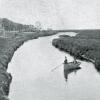Aerial look at Lewes in 1939
Lewes is a town steeped in history, and some of that history is documented in this 1939 aerial photograph by J. Victor Dallin. Kings Highway runs from the bottom right to the upper left of this photograph. DeVries Circle is easily recognizable in the lower left, but it appears to be a dirt road. A few weeks ago, we showed an aerial photograph of the railroad running down the middle of Rehoboth Avenue in Rehoboth Beach. Trains using that railroad came from Lewes. In the 1930s, the Queen Anne Railroad ran through town, with the historic swing bridge providing access across the Lewes-Rehoboth Canal. The railroad also had a spur to the south to Rehoboth Beach until the early 1970s. That’s now the Junction & Breakwater Trail. When the swing bridge was determined to be unsafe, the rest of the railroad in Lewes was decommissioned in 2017 and the tracks were eventually removed. The state used the right of way to create the Lewes-to-Georgetown Trail, which will eventually connect Lewes to Georgetown.
Notably absent from this photograph is Freeman Highway. The second access to Lewes Beach opened to the public Dec. 29, 1965. It was named after astronaut Capt. Theodore C. Freeman, a local man who joined the NASA program and worked alongside Buzz Aldrin, Gene Cernan and other notable astronauts. Freeman died when he unexpectedly encountered a flock of snow geese during a routine flight near Ellington Air Force Base in Houston on Oct. 31, 1964. Prior to the opening of Freeman Highway and Freeman Bridge, all traffic to the Cape May-Lewes Ferry, which began operations July 1, 1964, had to use Savannah Road.





















































